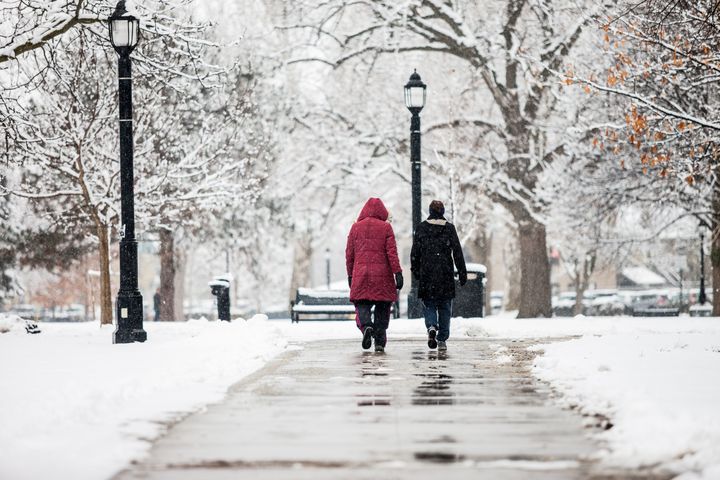An icy sidewalk, driveway or walking trail is a real danger. Roughly 800,000 people who slip and fall each year need medical attention, according to the Mayo Clinic. Even if you don’t end up in the hospital, slipping on ice can still be really painful, resulting in scraped knees, bruised elbows and other ailments.
“These falls are quite frequent ... 1 in 5 of them actually end up in an injury that requires care,” said Dr. Kariline Bringe, an orthopaedics surgeon at Mayo Clinic Health System in La Crosse, Wisconsin. “So, if we eliminate the fall, we’ll eliminate those injuries.”
When it comes to eliminating the fall, experts say there is one tip they especially want everyone to know when walking in icy, snowy weather.
To keep from slipping, walk like a penguin.
It may sound funny, but experts say the best way to keep yourself from slipping on the ice is by changing your stride.
“It’s called penguin walking because you do kind of look like a penguin while you’re doing this type of walk,” said Monica Leach, a physical therapist and board-certified clinical specialist in geriatric physical therapy at the Cleveland Clinic.
Here’s how to do the penguin walk, as explained by Leach:
- “Keep your knees slightly bent so you’re in an active position, ready to react if you need to.”
- “You’re pointing your feet slightly outward, you have your arms out at your side to help balance you.”
- “And you’re walking [slowly] with a flat foot or a shuffle step almost.”
- “[You’re] keeping your centre of gravity over your feet — so you might be like leaning forward just a little bit.”
Here are a few videos that demonstrate the walking style.
Shuffled, penguin-like steps keep you more stable.
“I think the big key here is slowing down, taking these small shuffling steps,” Bringe said.
The reason has a lot to do with friction and gravity. “As it gets icy out there and things get slippery, the larger our steps, the more force you’re coming across. It’s going to increase the likelihood that you slip,” Bringe explained.
Conversely, penguin-like steps ― small, slow and shuffled ― are going to decrease your risk of slipping, she said.
“If you do slip, you don’t have so much momentum behind it. So you’re less likely to slide a long way,” Bringe said. And with your centre of gravity above your feet, it’s less likely that a small slip will turn into a big fall.
With your arms free, you can catch yourself if you do end up falling.
Another thing that makes this an efficient way of walking is the fact that your hands are free.
“Your arms are free and able to come out from your body — that will also help improve your balance and decrease those risks of falls,” Bringe explained. “And, if you do fall, [it] gives you an opportunity to hopefully catch yourself before you bang your head.”
Leach emphasised that people need to keep their hands out of their pockets when walking in the snow. You can’t properly walk like a penguin if your hands are shoved in your pockets; it will affect your ability to balance or react if you need to.
The same goes for phones.
“I think the phone is an... extra piece to falls now, because all of us have our phone in our hand,” Bringe said. “We are checking our email, we’re texting people, we’re not looking at where we’re walking, we’re not examining that surface to make sure that there isn’t ice there... and so putting that phone away when it’s a little more hazardous is probably a good tip as well for avoiding those falls.”

Beyond walking like a penguin, here are some expert-backed tips for being out in the elements.
“We are so fortunate to have great predictions from our weather teams. We know that these things are coming,” Bringe said. “So, being prepared — you know it’s going to be snowing in two days, get that car filled up, make those trips to the grocery stores so you’re not out unnecessarily ... That makes it safer for you and safer for everybody who needs to be out there.”
If you do have to be out in the snow and you require a walker or a cane, make sure you don’t forget your assistive devices at home, Bringe said.
Additionally, make sure you’re wearing supportive winter shoes with traction. According to the Mayo Clinic, it’s important to wear shoes or boots that have “deep-grooved, nonskid, rubber treads.”
Leach said you should also be extra cognisant of your surroundings. It’s important to look up and make sure nothing is in front of you ― and also to look down from time to time, to make sure you aren’t about to walk on an icy surface.
“I’d say all dark, wet areas [are] probably slippery or icy,” Leach noted. “Even if you’re not sure, you might want to avoid those types of areas where you’re walking.”
If there’s a clear path where people have been walking already, you should walk through that path rather than veer off and seek out a shortcut. “You don’t want to do that, because you’re not sure what’s under those areas,” Leach said.
Overall, a crucial factor of the penguin-walking technique is going slow. So, Leach said, it’s important not to rush. “It’s better to be safe than sorry, so take your time.”
